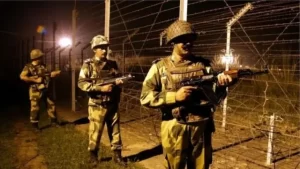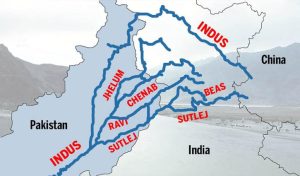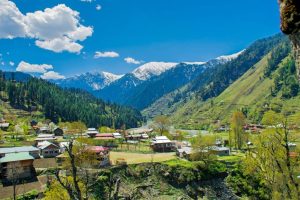Weaponizing the Waters: India’s Strike on Terrorism and Pakistan’s Coming Crisis

Surgical Strikes and Shattered Airbases
After the terrorist attack in Pahalgam by militants bred and nurtured in Pakistan, India’s most decisive response was a surgical strike targeting nine terrorist bases inside Pakistan. In retaliation, Pakistan launched several attacks on Indian soil, which led to Indian airstrikes that heavily damaged several Pakistani airbases, leaving many largely non-functional.
These developments brought the military capabilities of both India and Pakistan under intense scrutiny, along with the roles played by Chinese and Western weapons. Social media was flooded with dramatic theories, but those who relied on credible military journals and objective news outlets understood the real picture.
From General to Field Marshal: Pakistan’s Hollow Victory Lap
Pakistan glorified its military counteraction by awarding the title of Field Marshal to its army chief, Mr. Munir—making him the second person in the country’s history to receive this title. He earned it for resisting or responding to India’s surgical strikes. Time will judge this legacy. For comparison, Pakistan’s first Field Marshal, Ayub Khan, was cornered during the 1965 war and forced into a ceasefire through Soviet mediation. Afterwards, he regularly visited East Pakistan (now Bangladesh). During one such visit, in a meeting with senior political figures, former East Pakistan Chief Minister Ataur Rahman Khan posed a pointed question:
“Mr. President, Pakistan has a Field Marshal. India doesn’t even have a rank above General—then how did we lose the war?”

Field Marshal Ayub responded, “Because of India’s treachery. We attacked Kashmir, but instead of just defending, they escalated the conflict by attacking Sialkot.” Ataur Rahman Khan later recalled this candid admission in his autobiography with dry humor. Pakistan today, however, lacks statesmen of similar intellect and wit. For now, Munir’s supporters can only hope he won’t be held responsible for the devastated Sarghoda airbase in the future.
India’s True Strength Surfaced After the Strike
In light of India’s surgical strikes, Pakistan’s counterattacks, and the damage to Pakistani military infrastructure, any serious analysis must go beyond the immediate conflict. India had already demonstrated its capability to eliminate terrorists not only in neighboring countries but also in the West. However, this was India’s first time to fully expose its strategic strength to its neighbor.
The Indus Bombshell: Turning Off the Tap
In a landmark move following the Pahalgam attack, India unilaterally revoked the Indus Waters Treaty—a 65-year-old agreement brokered by the World Bank that allowed Pakistan to use nearly 80% of the waters from the Indus, Jhelum, and Chenab rivers. These rivers are the lifeblood of Pakistan’s agriculture-based economy.
Although India and Pakistan have fought four wars since the treaty was signed, India had never touched the agreement—until now. On May 2, Riffat Inam Butt, a renowned expert in international law, water diplomacy, and legal reform, wrote in Pakistan’s leading newspaper Dawn:
“If the Indus dries up, the people of Pakistan will be finished.”
He argued that in this era of climate change, if India were to cut off the river flow, it would trigger not only an agricultural and humanitarian catastrophe but also a severe energy crisis, since Pakistan’s major hydropower stations depend on Indus water.

Legal Hope or a Legal Mirage
As a water law expert, Butt pointed out the near-impossibility of legal victory for downstream nations. Disputes over water are long, uncertain, and often unresolved. He cited examples: the Middle East’s Jordan River, Egypt’s stand on the Nile against Ethiopia’s dam project, and the Iraq-Syria conflict with Turkey over the Tigris and Euphrates. None have seen successful international resolutions. “If the river is gone, so are we,” he wrote starkly.
Two weeks later, a World Bank official clarified that despite having brokered the Indus Treaty, the World Bank currently holds no authority to act on the matter. Even if this hadn’t reached the media, those familiar with today’s global economy and geopolitics know that India, now a major power, is under no obligation to heed the World Bank’s advice.
China’s Playbook: Dam the River, Rule the Region
In 2023, Nikkei Asia published a detailed report titled The Mekong’s Cry, highlighting how China’s dam projects have devastated agriculture in Vietnam, Cambodia, and Thailand. Though Western outlets and environmental activists raised concerns, no country could propose an alternative beyond talks and diplomacy. China built those dams only after gaining the full capacity to divert water for domestic use.
India is now following a similar trajectory. Positioned as the upper riparian power with technical know-how, it waited until it had the infrastructure to act—then moved decisively. It has revived century-old canal systems like the Kathua, New Pratap, and Ranbir canals to fully utilize upstream waters. Projects are underway to expand the Ranbir canal by 60 kilometers and the New Pratap canal by 34 kilometers.

India’s Silent Revolution: A Canal Comeback Decades in the Making
These canal projects have roots in the vision of scientist Meghnad Saha. With India’s economy booming, these projects have accelerated. Those following water trends or the future of freshwater as a strategic asset are already aware.
Anticipating glacial retreat in Sikkim—already underway—India had long prepared canal systems to divert Teesta River water for agriculture and forest conservation. Despite this, water from the Teesta now barely reaches rivers like the Mahananda in summer. Meanwhile, China is constructing dams at the Brahmaputra’s source to ensure its own maximum use. Scientific research and canal networks back this effort.
The British began analyzing Ganges water flow long ago, leading to the construction of the Farakka Barrage. This, along with linked canals, has had negative effects on Bangladesh—partly mitigated by the 1996 Ganges Water Treaty, which ends in 2026. West Bengal argues the Kolkata port wasn’t saved; instead, the Haldia port was created. In Bihar, the barrage is blamed for intensified monsoon flooding.
India is now monitoring the feeder canals and flood conditions in Bihar to ensure it uses the Ganges to its fullest potential.
Around the world, upper riparian states are prioritizing national control of cross-border rivers amid climate change. During Trump’s campaign, a joke was made about Canada becoming another U.S. state. But the real issue was the unresolved Columbia River treaty. Even there, Canada’s reliance on international law holds little sway—bilateral diplomacy remains supreme.
A Field Marshal, A Fading River, and A Nation at Risk
So now, even though Pakistan’s army chief has been elevated to Field Marshal status in the post-Pahalgam “new normal,” he stands not in a triumphant Kashmir, but along the drying banks of the Indus. As Butt warned, “The impact will not be limited to agriculture. Reduced Indus flow will destroy crops, cause food shortages, and increase border conflicts in this already volatile nuclear region. The collapse of the Indus Treaty would be more than a diplomatic failure—it would be a humanitarian disaster.”
In reality, Pakistan no longer holds Kashmir. Global forums have limited interest in water disputes, yet Pakistan will now have to abandon its Kashmir rhetoric and speak urgently, repeatedly, about the looming Indus-linked humanitarian crisis.

India’s Global Campaign: Terror Has No Excuse
Meanwhile, India is dispatching political envoys across the world with a single message: India did not start a war. Pakistan is not only fertile ground for terrorism but its government actively supports and participates in international terror networks and religious extremism.
This form of terrorism has waged a silent global war for over three decades—wrecking economies and shattering public safety. Wherever such terrorism takes root, it threatens the entire world. That’s why India claims the moral right—even beyond legal frameworks—to use its water weapon against figures like Field Marshal Munir who continue to play dangerous games with terrorism.
Pahalgam: A New 9/11 That Unleashed India’s Water Weapon
The Pahalgam attack has given India the opportunity to freely wield its most potent weapon: water. Much like 9/11, it has reminded the world that terrorist states—and the governments that shelter them—are the gravest threat to global peace. And against them, the world must be ready for even the responses.
Author: Swadesh Roy
Recipient of the highest national journalism honor; Editor, Sarakhon and The Present World.























